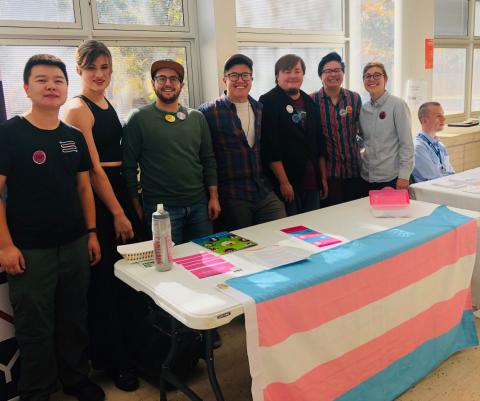
Trans Educators have an important place in our schools
In schools across the nation, transgender students have been winning hard-fought battles for better treatment. But most of these youth still attend a school with no out trans teachers on staff. This year during Trans Awareness Week, we’re highlighting the strengths and needs of trans educators.
Many trans youth have never met a trans adult in person, so it is hard for them to imagine what their futures hold. Trans teachers are uniquely equipped to act as role models. Our daily presence in schools is proof that it is possible to grow up to be a happy and successful trans adult.
This year, we co-founded the Colorado Transgender and Nonbinary Educators Network (CO-TEN), a growing community of current and former classroom teachers. We advocate for schools to recognize our strengths and to honor our needs. While some of us are thriving in our schools, others have faced serious mistreatment and have been pushed out of the classroom.
Together, CO-TEN members have identified five best practices for school leaders and staff allies who work with trans educators.
1. Trans People are the experts of their Needs
Sam: My first principal, like many administrators, had no prior experience working with openly trans staff. When I said that I wanted to come out as a post-transition trans man, he trusted me as the expert on my needs. He listened more than he talked as we built a plan for me to share my story at a whole-school meeting. He also did his homework, speaking with an equity consultant to refine a plan for inviting families to attend. My coming out was a success because I had my principal’s confidence. Students, parents, and teachers alike applauded my courage and vulnerability.
2. Identify and interrogate your own biases.
Sam: Although most colleagues respond positively to my trans identity, I have worked with well-meaning people who were unaware of their biases. One administrator was fixated on the possible negative outcomes of my coming out. He said that he would “definitely have to deal with some upset parents”, but he overlooked the positive influence that I would have on student culture. I’ve had racist and untrue assumptions used as rationale for transphobia. For example, a teacher advised me to avoid schools with large Latinx populations “because the families were likely to be Catholic and transphobic”. In reality, I later taught at a 90% Latinx school where coming out was again a positive experience. You can’t use someone’s culture or religious beliefs to assume if they’ll be supportive or unsupportive.
3. Stand behind your trans educators.
Joel: I am a trans man who is often assumed to be cis. When I asked my school district about sharing my trans identity openly in the classroom, I received mixed messages and restrictions that were difficult to follow. At one point I was told that I could answer questions about my identity, but that I couldn’t bring it up myself. Later on, when my gender identity came up in conversation with a student, I was threatened with disciplinary action. An internal investigation into my claim of discrimination resulted in the district being found not guilty of any wrongdoing. I was disappointed that my supervisors chose to treat my identity as a controversy to hide rather than a positive opportunity, that my need to be out at school was not made a priority, and that my complaint about being forced into the closet was dismissed.
4. Share the work of creating an inclusive school climate.
Joel: At one point I felt like I was working two full time jobs, one as a music teacher and one as an unpaid LGBTQ+ organizer and policy consultant. A small handful of staff in my district were advocating for my right to be an out trans teacher. Many more staff were supportive but didn’t have enough knowledge to help, and a few individuals seemed to be actively setting up barriers for me. I suggested that the district hire an independent consultant such as A Queer Endeavor or GLSEN to help, but this was not made a priority.
5. Develop official policies in your school or district.
Does your school have guidelines on what to do when a student transitions? What about when a staff member transitions or comes out? GLSEN provides a model policy on supporting trans students. The Toronto, Chicago, and Los Angeles Unified school districts’ policies, as well as Washington State law, all have sections addressing the needs of trans staff.
A strong policy should include:
- Easy access to name and gender marker changes in staff information systems
- Trans-inclusive health benefits
- Procedures allowing staff to keep their trans status confidential or to come out in the school community as they choose
- A clear system for reporting harassment and discrimination
- Gender diversity training for all school leaders
We teamed up with trans filmmaker Z Griffler to turn these lessons into a short video. Check out Five Best Practices To Support And Learn From Trans Educators. We hope you will use and share these practices to advance trans educator awareness in your school. And if you have no out trans staff right now, we hope you will work to make your school a safe and inviting place for a trans person to work.
--
Joel Zigman (he/him/his) is a composer, educator, and activist living in Denver, CO. He is a former elementary school music teacher currently teaching private music lessons.
Sam Long (he/him/his) teaches science at Standley Lake High School in Westminster, CO. Sam also trains other teachers in developing gender-inclusive biology curriculum.
